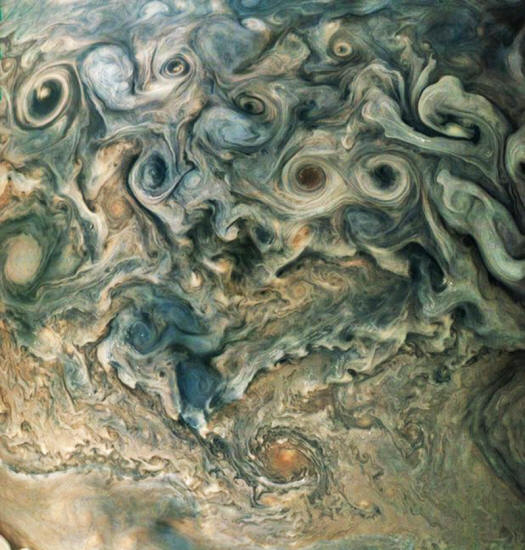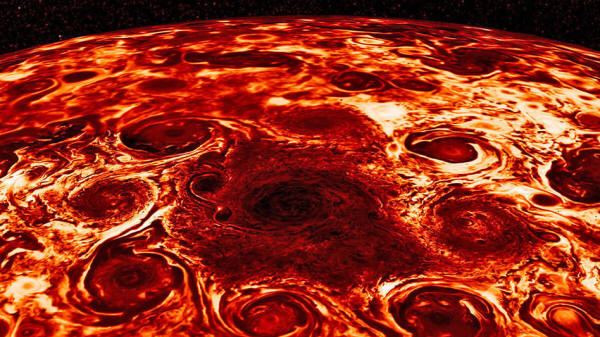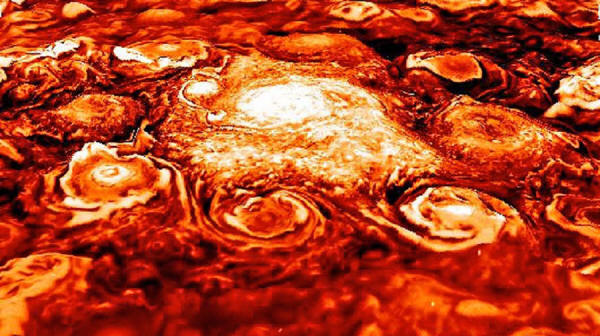|

March 07, 2018
from
Ancient-Code Website
Spanish version

An
image of the North polar region of Jupiter.
Photograph: MSSS/SwRI/JPL-Caltech/NASA
Since the time of Galileo, the observers of the stars have looked at
Jupiter and wondered what lies beneath the striking clouds that
cover the Gas giants atmosphere.
The analysis of the latest data from the Juno probe, published in
March of 2018, will help answer that question.
The scientific papers
also help understand what lies beyond Jupiter's thick envelope of
gases and whether there is a nucleus that was formed from rock,
which could help astronomers answer one of the biggest mysteries
about the origin of the Solar System.
According to the latest mission reports and a series of scientific
studies, NASA's probe observes huge storms, detected winds more than
3,000 kilometers below the clouds that cover its atmosphere and
details about an almost unknown nucleus.
Jupiter has more mass than the rest of the planets of the Solar
System together.
Jupiter has the shortest days of all the planets in our Solar
System. Since Jupiter is a gas planet, it does not rotate as a solid
sphere. Jupiter's equator rotates a bit faster than its polar
regions at a speed of 28,273 miles/hour (about 43,000
kilometers/hour).
This makes the Gas Giant
the
fastest spinning planet in our Solar System
rotating on average once in just under 10 hours.
With these
characteristics, its gravitational field should be uniform, but for
some reason, it is not, there are areas where the giant's pull is
greater, and until now researchers had no idea why.
However, four
studies published in Nature provide an explanation for this
phenomenon and describe what the interior of the planet is like.

This composite image, derived from data
collected by the Jovian Infrared Auroral Mapper
(JIRAM) instrument aboard NASA's Juno mission to
Jupiter, shows the central cyclone at the
planet's north pole and the eight cyclones that
encircle it.
Image Credit: NASA/JPL-Caltech/SwRI/ASI/INAF/JIRAM
Scientists analyzed data
obtained by NASA's Juno probe and have found that 'odd Gravity and
rapid jest streatms lie around 3,000 kilometers below the surface of
the clouds that cover the planet.
Furthermore, experts have found that at each pole on Jupiter exists
a cyclone which is thousands of miles in diameter.
The study also explains
how these cyclones appear to be surrounded by a polygonal
arrangement of storms - eight in the north and five in the south.
"Before Juno, we had
no idea what the weather was like near Jupiter's poles.
Now, we have been
able to observe the polar weather up-close every two months,"
said Alberto Adriani, Juno co-investigator from the Institute
for Space Astrophysics and Planetology, Rome, and lead author of
the paper.
"Each one of the northern cyclones is almost as wide as the
distance between Naples, Italy and New York City - and the
southern ones are even larger than that. They have very violent
winds, reaching, in some cases, speeds as great as 220 mph (350
kph).
Finally, and perhaps
most remarkably, they are very close together and enduring.
There is nothing else like it that we know of in the solar
system."
The discoveries reveal
unprecedented details about Jupiter's interior and could help
experts finally understand the dynamics that exist inside the gas
giant's atmosphere and other similar planets across the galaxy.
"These
astonishing science results are yet another example of Jupiter's
curve balls and a testimony to the value of exploring the
unknown from a new perspective with next-generation
instruments.
Juno's unique
orbit and evolutionary high-precision radio science and infrared
technologies enabled these paradigm-shifting discoveries," said
Scott Bolton, principal investigator of Juno from the Southwest
Research Institute, San Antonio.
"Juno is only
about one third the way through its primary mission, and already
we are seeing the beginnings of a new Jupiter."
"Juno's
measurement of Jupiter's gravity field indicates a north-south
asymmetry, similar to the asymmetry observed in its zones and
belts," said Luciano Iess, Juno co-investigator from Sapienza
University of Rome, and lead author on a Nature paper on
Jupiter's gravity field.

This computer-generated image is based on an
infrared image of Jupiter's north polar region
that was acquired on February 2, 2017, by the
Jovian Infrared Auroral Mapper (JIRAM)
instrument aboard Juno during the spacecraft's
fourth pass over Jupiter.
Image Credit: NASA/JPL-Caltech/SwRI/ASI/INAF/JIRAM
"Galileo observed the
stripes on the Gas Giant more than 400 years ago," said Yohai
Kaspi, Juno co-investigator from the Weizmann Institute of
Science, Rehovot, Israel, and lead author of a Nature paper on
Jupiter's deep weather layer.
"Until now, we only had a superficial understanding of them and
have been able to relate these stripes to cloud features along
Jupiter's jets.
Now, following Juno's
gravity measurements, we understand how deep the jets extend and
what their structure is beneath the visible clouds.
We are basically
going from a 2-D picture to a 3-D version in high definition."
The result was a huge
surprise for the Juno mission scientists because it indicated that
the weather layer of Jupiter was more massive, extending much deeper
than previously thought.
The Jovian weather layer,
from its very top to a depth of 1,900 miles (3,000 kilometers),
contains about one percent of Jupiter's mass, which is approximately
3 Earth masses.
"By contrast, Earth's
atmosphere is less than one-millionth of the total mass of
Earth," said Kaspi.
"The fact that
Jupiter has such a massive region rotating in separate east-west
bands is a surprise."
The finding is important
for understanding the nature and possible mechanisms driving these
strong jet streams.
In addition, the gravity signature of the jets is entangled with the
gravity signal of Jupiter's core.
The scientific studies
|




